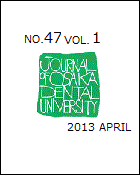Volume 40, Issue 1
Displaying 1-11 of 11 articles from this issue
- |<
- <
- 1
- >
- >|
-
Article type: Article
2006 Volume 40 Issue 1 Pages 1-5
Published: 2006
Released on J-STAGE: December 15, 2016
Download PDF (755K) -
Article type: Article
2006 Volume 40 Issue 1 Pages 7-11
Published: 2006
Released on J-STAGE: December 15, 2016
Download PDF (645K) -
Article type: Article
2006 Volume 40 Issue 1 Pages 13-17
Published: 2006
Released on J-STAGE: December 15, 2016
Download PDF (1187K) -
Article type: Article
2006 Volume 40 Issue 1 Pages 19-23
Published: 2006
Released on J-STAGE: December 15, 2016
Download PDF (1888K) -
Rate of protein transfer from sodium dodecyl sulfate-polyacrylamide gels to nitrocellulose membranesArticle type: Article
2006 Volume 40 Issue 1 Pages 25-30
Published: 2006
Released on J-STAGE: December 15, 2016
Download PDF (1341K) -
Article type: Article
2006 Volume 40 Issue 1 Pages 31-36
Published: 2006
Released on J-STAGE: December 15, 2016
Download PDF (610K) -
Article type: Article
2006 Volume 40 Issue 1 Pages 37-42
Published: 2006
Released on J-STAGE: December 15, 2016
Download PDF (2136K) -
Article type: Article
2006 Volume 40 Issue 1 Pages 43-46
Published: 2006
Released on J-STAGE: December 15, 2016
Download PDF (1176K) -
Article type: Article
2006 Volume 40 Issue 1 Pages 47-52
Published: 2006
Released on J-STAGE: December 15, 2016
Download PDF (634K) -
Article type: Article
2006 Volume 40 Issue 1 Pages 53-60
Published: 2006
Released on J-STAGE: December 15, 2016
Download PDF (1871K) -
Article type: Article
2006 Volume 40 Issue 1 Pages 61-65
Published: 2006
Released on J-STAGE: December 15, 2016
Download PDF (477K)
- |<
- <
- 1
- >
- >|
